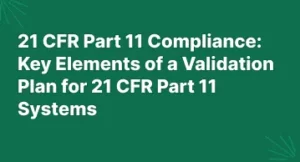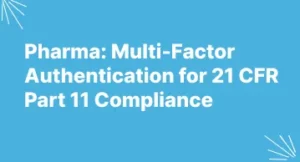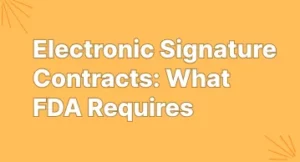21 CFR Part 11 Compliance: The Role of Audit Trails
Introduction
In today’s digital era, regulatory compliance is a top priority for industries dealing with electronic records and signatures. If you work in pharmaceuticals, biotechnology, or any FDA-regulated field, you’ve likely come across 21 CFR Part 11 compliance. This regulation ensures that electronic records are trustworthy, reliable, and equivalent to paper records.
One of the key components of 21 CFR Part 11 compliance is audit trails. These act as digital footprints, tracking every change made to electronic documents, ensuring transparency, security, and accountability. Without a robust audit trail, proving data integrity becomes challenging, potentially leading to non-compliance issues.
This blog will break down the importance of audit trails in 21 CFR Part 11 compliance, how they help in lab accreditation, and their role in identity verification.
What is 21 CFR Part 11 Compliance?
Before we dive into audit trails, let’s quickly understand 21 CFR Part 11. It is an FDA regulation that governs electronic records and electronic signatures, ensuring they are secure, traceable, and legally equivalent to paper-based records.
To comply with 21 CFR Part 11, companies must:
- Implement access controls to prevent unauthorized changes.
- Use audit trails to track modifications and approvals.
- Ensure electronic signatures are secure and verifiable.
- Maintain data integrity with strict validation processes.
Non-compliance can result in FDA warnings, hefty fines, and even legal action. That’s why having an effective audit trail system is non-negotiable for regulated industries.
The Role of Audit Trails in 21 CFR Part 11 Compliance
1. Ensuring Data Integrity and Transparency
An audit trail records every action taken on a digital document—whether it’s an update, deletion, or approval. This provides a clear and chronological history of changes, which is crucial in proving that data has not been altered improperly.
For example, in a pharmaceutical company, if a researcher updates a batch record, the audit trail captures:
- Who made the change
- When the change was made
- What was changed
- The reason for the change (if required)
This transparency ensures data integrity, reducing the risk of falsification or manipulation.
2. Enhancing Lab Accreditation
Audit trails play a significant role in lab accreditation processes. Laboratories must comply with strict regulations to maintain accreditation, and part of this compliance includes ensuring traceability of data changes.
Regulatory bodies like ISO 17025 and FDA’s GLP (Good Laboratory Practice) require that labs maintain reliable documentation of all testing procedures. An audit trail ensures that:
- Every test result modification is recorded.
- No unauthorized changes occur.
- All approvals and reviews are logged in properly.
Without a compliant audit trail, labs risk losing their accreditation and credibility.
3. Strengthening Identity Verification
Audit trails don’t just track data changes—they also help in identity verification. In 21 CFR Part 11 compliance, electronic signatures must be unique to individuals, ensuring accountability.
A compliant audit trail ensures:
- Every action is linked to a specific user.
- User authentication is logged (passwords, biometrics, or multi-factor authentication).
- Any unauthorized access attempts are recorded and flagged.
This level of security prevents fraudulent activities and ensures that only authorized personnel can access or modify sensitive records.
Key Features of a Compliant Audit Trail System
To meet 21 CFR Part 11 compliance requirements, an audit trail system should include:
To comply with 21 CFR Part 11, companies must:
- Automatic Logging – Captures every change made to a document in real time.
- Time-Stamped Records – Each entry must include a date and time stamp for accuracy.
- Read-Only Logs – Audit trails must be tamper-proof, preventing users from modifying records.
- User Identification – Every entry should be linked to a verified user.
- Change Justifications – Some actions require a reason for modification.
- Data Retention – Audit logs should be stored securely for a specified duration.
How to Implement an Effective Audit Trail for 21 CFR Part 11 Compliance
1. Choose a Compliant Digital Solution
Using an FDA-compliant electronic document management system (EDMS) like MSB Docs ensures that all audit trails meet regulatory standards. MSB Docs provides:
- Automated tracking of document changes
- Secure electronic signatures
- Tamper-proof logs for compliance
2. Establish Clear Policies and SOPs
Organizations must define standard operating procedures (SOPs) for:
- Who can access or modify records
- How changes should be documented
- How long audit trails should be retained
3. Train Employees on Compliance Requirements
Even the best audit trail system is ineffective if employees don’t follow compliance protocols. Regular training sessions help staff understand:
- The importance of audit trails
- How to log changes correctly
- How to maintain compliance with 21 CFR Part 11
4. Conduct Regular Audits
Routine audits ensure that your audit trail system is functioning correctly. Internal and external auditors should verify that:
- All changes are logged accurately
- Access controls are working effectively
- Any compliance gaps are addressed
The Future of Audit Trails in Regulatory Compliance
With advancements in blockchain technology and AI-driven monitoring, audit trails are becoming even more secure and automated. Future trends include:
- Blockchain-based audit trails for enhanced data integrity
- AI-powered anomaly detection to identify fraudulent activities
- Cloud-based compliance solutions for remote accessibility
These innovations will further strengthen 21 CFR Part 11 compliance, making regulatory adherence easier for businesses.
Conclusion
Audit trails are more than just compliance checkboxes—they are essential for ensuring data integrity, security, and regulatory adherence. Whether for lab accreditation, identity verification, or electronic recordkeeping, a robust audit trail system is a must-have for FDA-regulated industries.
If you’re looking for a reliable solution, MSB Docs offers a fully 21 CFR Part 11-compliant platform with built-in audit trails, electronic signatures, and secure document management.
For a deeper dive into 21 CFR Part 11 compliance, check out our blog: 21 CFR Part 11 Compliance Guide: How MSB Docs Helps You Comply.
Ready to enhance your compliance strategy? Contact us today to see how MSB Docs can help you stay audit-ready!







